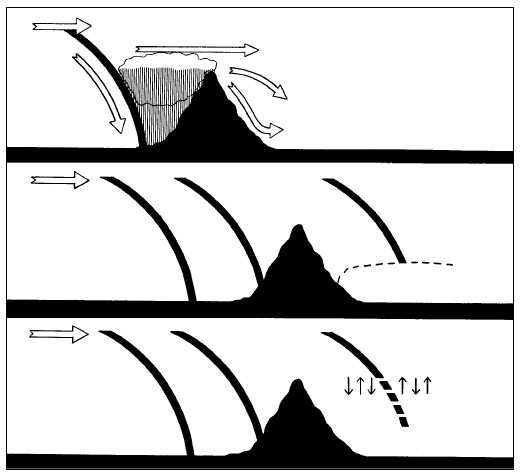EFFECTS CAUSED BY MOVEMENT
The weather is greatly affected by the movement of
frontal systems. From the time the front develops until
it passes out of the weather picture, it is watched
closely. The speed of the movement of frontal systems
is an important determining factor of weather
conditions. Rapidly moving fronts usually cause more
severe weather than slower moving fronts. Fast-moving
cold fronts often cause severe prefrontal squall lines
that are extremely hazardous to flying. The fast-moving
front does have the advantage of moving across the area
rapidly, permitting the particular locality to enjoy a
quick return of good weather. Slow-moving fronts, on
the other hand, may cause extended periods of
unfavorable weather. A stationary front may bring bad
weather and can disrupt flight operations for several
days if the frontal weather is sitting over your station.
Knowledge of the speed of the frontal system is
necessary for accurate forecasting. If the front has a
somewhat constant speed, it makes your job and the
forecaster’s job comparatively easy. However, if the
speed is erratic or unpredictable, you may err as far as
time and severity are concerned. If a front was
ultimately forecast to pass through your station and
instead becomes stationary or dissipates, the station
forecast will be a total bust.
OROGRAPHIC EFFECTS
Mountain ranges affect the speed, slope, and
weather associated with a front. The height and
horizontal distance of the mountain range along with
the angle of the front along the mountain range are the
influencing factors. Mountain ranges can affect cold
fronts, warm fronts, and occluded fronts differently.
Cold Fronts
As a cold front approaches a mountain range, the
surface portion of the front is retarded and the upper
portion pushes up and over the mountain. On the
windward side of the mountain, warm air is pushed up
along the mountain slope because of the additional lift
of a now steeper frontal slope and the mountain itself
(view A of fig. 4-44). After the front passes the crest of
the mountain, the air behind the front commences to
4-46
COLD
A
WARM
CLEARING
B
COLD
WARM
COLDER
C
EXTREME
INSTABILITY
STAGNANT WARM AIR
AG5f0444
Figure 4-44.—Orographic effects on a cold front.


